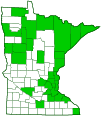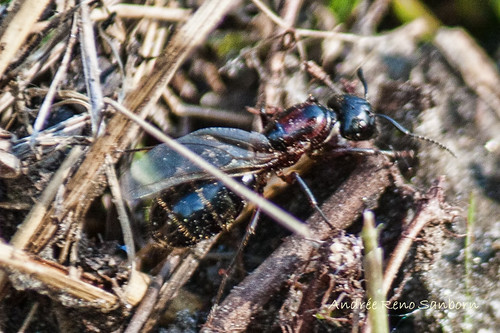New York carpenter ant
(Camponotus novaeboracensis)
Conservation • Description • Habitat • Ecology • Distribution • Taxonomy
|
|
||||||||||||||
Description |
There are more than 1,000 species of carpenter ants worldwide. New York carpenter ant is a large ant but only a medium-sized carpenter ant. It occurs from coast to coast across northern United States and southern Canada. In the United States it is most common from the northeast to the Great Lakes states. Colonies can contain up to 2,000 individuals. They are found in woodlands and rural areas in rotting wood in stumps, deadfall, and old houses. They are active from the spring thaw the the fall frost. Workers are ¼″ to ⅝″ long. There are two sizes or castes; majors and minors. Minors are small and perform most of the everyday mundane tasks in the colony. They rarely if ever venture outside the nest. Majors are larger and are tasked with defending the colony and dealing with large food items. The head is black and is sparsely covered with erect hairs. The surface is pitted with large and small punctures. There are two large compound eyes and no simple eyes (ocelli). The antennae have 12 segments. The basal segment (scape) of each antenna is very long and is not covered with erect hairs except at the very tip. The distance from the base of the scape to the middle face plate (clypeus) is equal to or greater than the maximum width of the scape. The thorax is dark reddish-brown. On newly emerged ants it is yellow or orange, darkening over time. The abdomen consists of a large first segment (propodeum) that is fused to the thorax; a narrow waist-like second segment (petiole); and the bulbous remainder (gaster). The propodeum and petiole are dark reddish-brown. The gaster is black, shiny, and sparsely covered with short, erect, very fine, pale yellow or white hairs. The hairs are well-spaced and do not overlap adjacent hairs. When viewed in profile, the entire second segment of the body (mesosoma) consisting of the thorax and the propodeum, forms a continuous curve. The legs are dark reddish-brown, the same color as the thorax or darker. The males are similar but entirely black. The wings are mostly clear, lightly tinged yellowish-brown, and have yellow veins and stigma. The queen is fat and has a small head (fully claustral). The wings are strongly tinged yellowish-brown and have yellow veins and stigma. It is otherwise similar to the worker. |
Size |
Queen: 9 ⁄16″ to 11 ⁄16″ Worker (majors and minors): ¼″ to ⅝″ |
Similar Species |
Eastern black carpenter ant (Camponotus pennsylvanicus) has a black thorax. |
Habitat |
Moist woodlands |
Ecology |
Season |
Early spring to late fall |
Behavior |
They are active from the spring thaw the the fall frost, and mostly at night but also during the day. Mating flights take place in May and June. The entire colony becomes dormant (enters diapause) in the winter. |
Life Cycle |
A colony will have only a single queen and can last up to ten years. |
Larva Food |
They excavate nests in decaying wood. They do not eat the wood but expel the sawdust-like debris (frass) from the nest. |
Adult Food |
Dead insects, aphid honeydew, and tree sap |
Distribution |
||
|
Sources |
|
| 4/28/2024 | ||
Occurrence |
||
Common and widespread |
||
Taxonomy |
|
Order |
Hymenoptera (Ants, Bees, Wasps, and Sawflies) |
Suborder |
Apocrita (Narrow-waisted Wasps, Ants, and Bees) |
Infraorder |
Aculeata (Ants, Bees, and Stinging Wasps) |
Superfamily |
Formicoidea |
Family |
Formicidae (ants) |
Subfamily |
Formicinae |
Tribe |
Camponotini |
Genus |
Camponotus (carpenter ants) |
Subgenus |
Camponotus (true carpenter ants) |
Subordinate Taxa |
|
|
|
Synonyms |
|
Camponotus noveboracensis Formica novaeboracensis |
|
Common Names |
|
New York carpenter ant |
|
Glossary
Clypeus
On insects, a hardened plate on the face above the upper lip (labrum).
Gaster
The bulbous part of the abdomen of ants, bees, and wasps. In ants it usually begins at segment three.
Scape
In plants: An erect, leafless stalk growing from the rootstock and supporting a flower or a flower cluster. In insects: The basal segment of the antenna.
Visitor Photos |
||
Share your photo of this insect. |
||
This button not working for you? |
||
Alfredo Colon |
||
 |
 |
|
 |
 |
|
 |
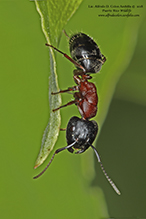 |
|
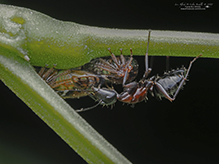 |
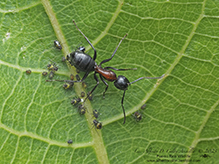 |
|
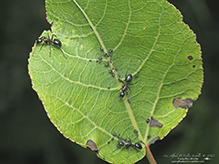 |
 |
|
MinnesotaSeasons.com Photos |
||
|
||
|
||

Visitor Videos |
||
Share your video of this insect. |
||
This button not working for you? |
||
|
Other Videos |
||
Camponotus noveboracensis super major hatching |
About
Published on Jun 15, 2018 Today I captured a great video of a Camponotus noveboracensis super major hatching! I hope you enjoy! |

Visitor Sightings |
||
Report a sighting of this insect. |
||
This button not working for you? |
||
Alfredo Colon |
Location: Albany, NY |
 |
Alfredo Colon |
Location: Albany, NY |
 |
| Alfredo Colon 7/6/2024 |
Location: Albany, NY |
 |
| Alfredo Colon 8/22/2022 |
Location: Albany, NY |
 |
| Alfredo Colon 8/19/2022 |
Location: Albany, NY |
 |
| Alfredo Colon 8/4/2022 |
Location: Albany, NY |
 |
| Alfredo Colon 7/9/2018 |
Location: Woodbury, Minnesota |
 |
MinnesotaSeasons.com Sightings |
||
|

Created: 12/26/2018 Last Updated: © MinnesotaSeasons.com. All rights reserved. |
